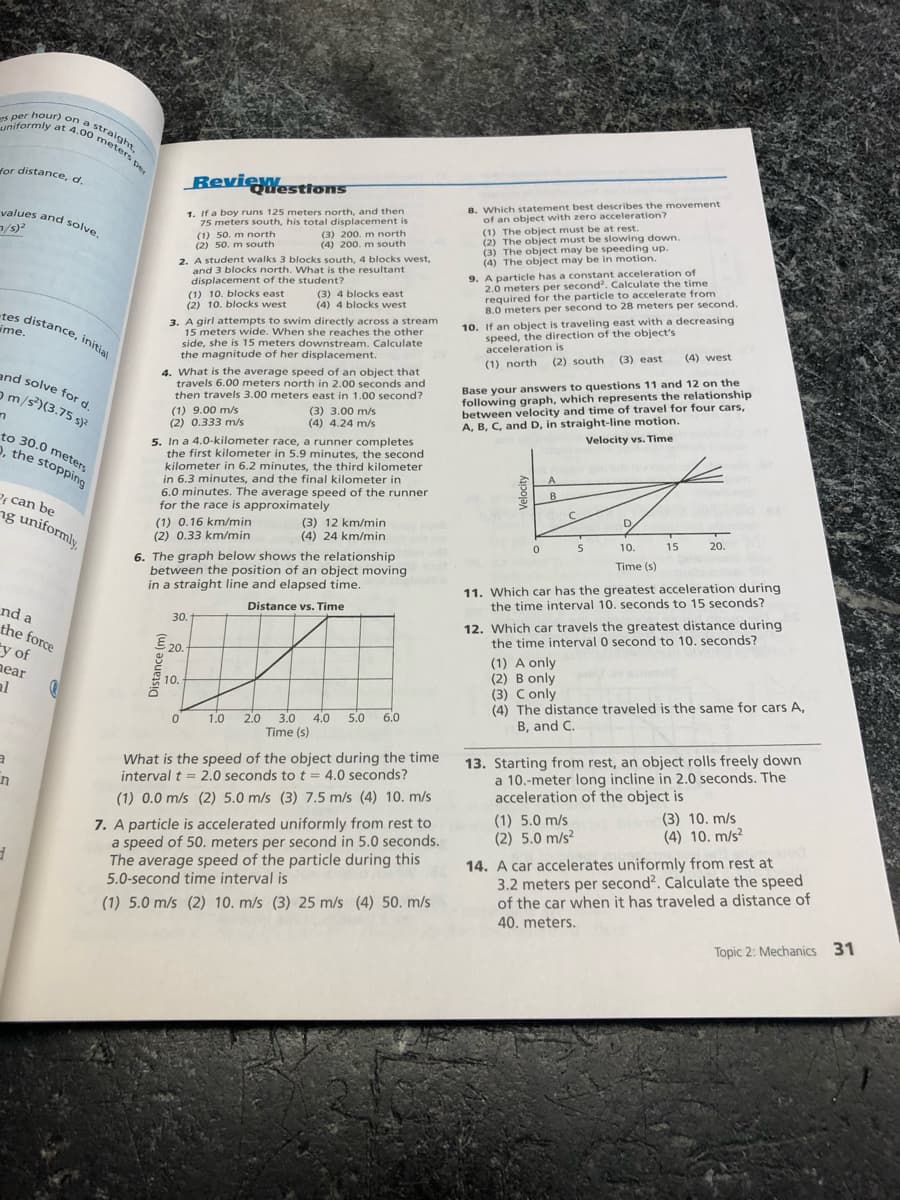2. A student walks 3 blocks south, 4 blocks west, and 3 blocks north. What is the resultant displacement of the student? (1) 10. blocks east (2) 10. blocks west (3) 4 blocks east (4) 4 blocks west
2. A student walks 3 blocks south, 4 blocks west, and 3 blocks north. What is the resultant displacement of the student? (1) 10. blocks east (2) 10. blocks west (3) 4 blocks east (4) 4 blocks west
University Physics Volume 1
18th Edition
ISBN:9781938168277
Author:William Moebs, Samuel J. Ling, Jeff Sanny
Publisher:William Moebs, Samuel J. Ling, Jeff Sanny
Chapter4: Motion In Two And Three Dimensions
Section: Chapter Questions
Problem 54P: The Lunar Roving Vehicle used In NASA’s late Apollo missions reached an unofficial lunar land speed...
Related questions
Question
help with question number 2

Transcribed Image Text:required for the particle to aceoters per second.
uniformly at 4.00 meters per
s per hour) on a
-tes distance, initial
s per hour) on a
uniformly at 4.00
straight.
for distance, d.
BeviexYesttons
8. Which statement best describes the movement
of an object with zero acceleration?
(1) The object must be at rest.
(2) The object must be slowing down.
(3) The object may be speeding up.
(4) The object may be in motion.
9. A particle has a constant acceleration of
2.0 meters per second'. Calculate the time
required for the particle to accelerate from
8.0 meters per second to 28 meters per second.
1. If a boy runs 125 meters north, and then
75 meters south, his total displacement is
(3) 200. m north
(4) 200. m south
yalues and solve.
(1) 50. m north
(2) 50. m south
2. A student walks 3 blocks south, 4 blocks west,
and 3 blocks north. What is the resultant
displacement of the student?
(1) 10. blocks east
(2) 10. blocks west
(3) 4 blocks east
(4) 4 blocks west
tes distance, initial
ime.
3. A girl attempts to swim directly across a stream
15 meters wide. When she reaches the other
side, she is 15 meters downstream. Calculate
the magnitude of her displacement.
10. If an object is traveling east with a decreasing
speed, the direction of the object's
acceleration is
(4) west
(2) south (3) east
(1) north
4. What is the average speed of an object that
travels 6.00 meters north in 2.00 seconds and
then travels 3.00 meters east in 1.00 second?
Base your answers to questions 11 and 12 on the
following graph, which represents the relationship
between velocity and time of travel for four cars,
A, B, C, and D, in straight-line motion.
and solve for d
om/s)(3.75 s)?
(1) 9.00 m/s
(2) 0.333 m/s
(3) 3.00 m/s
(4) 4.24 m/s
Velocity vs. Time
to 30.0 meters
2, the stopping
5. In a 4.0-kilometer race, a runner completes
the first kilometer in 5.9 minutes, the second
kilometer in 6.2 minutes, the third kilometer
in 6.3 minutes, and the final kilometer in
6.0 minutes. The average speed of the runner
for the race is approximately
A
B
Pf can be
ng uniformly.
D
(1) 0.16 km/min
(2) 0.33 km/min
(3) 12 km/min
(4) 24 km/min
15
20.
5
10.
6. The graph below shows the relationship
between the position of an object moving
in a straight line and elapsed time.
Time (s)
11. Which car has the greatest acceleration during
the time interval 10. seconds to 15 seconds?
12. Which car travels the greatest distance during
the time interval 0 second to 10. seconds?
Distance vs. Time
nd a
30.
the force
ty of
near
E 20.
(1) A only
(2) B only
(3) Conly
(4) The distance traveled is the same for cars A,
B, and C.
10.
al
3.0
4.0
5.0
6.0
2.0
Time (s)
1.0
What is the speed of the object during the time
interval t = 2.0 seconds to t = 4.0 seconds?
13. Starting from rest, an object rolls freely down
a 10.-meter long incline in 2.0 seconds. The
acceleration of the object is
(1) 0.0 m/s (2) 5.0 m/s (3) 7.5 m/s (4) 10. m/s
(1) 5.0 m/s
(2) 5.0 m/s?
(3) 10. m/s
(4) 10. m/s?
7. A particle is accelerated uniformly from rest to
a speed of 50. meters per second in 5.0 seconds.
The average speed of the particle during this
5.0-second time interval is
14. A car accelerates uniformly from rest at
3.2 meters per second?. Calculate the speed
of the car when it has traveled a distance of
(1) 5.0 m/s (2) 10. m/s (3) 25 m/s (4) 50. m/s
40. meters.
Topic 2: Mechanics 31
Distance (m)
Expert Solution
This question has been solved!
Explore an expertly crafted, step-by-step solution for a thorough understanding of key concepts.
This is a popular solution!
Trending now
This is a popular solution!
Step by step
Solved in 2 steps with 1 images

Recommended textbooks for you

University Physics Volume 1
Physics
ISBN:
9781938168277
Author:
William Moebs, Samuel J. Ling, Jeff Sanny
Publisher:
OpenStax - Rice University

College Physics
Physics
ISBN:
9781938168000
Author:
Paul Peter Urone, Roger Hinrichs
Publisher:
OpenStax College

Glencoe Physics: Principles and Problems, Student…
Physics
ISBN:
9780078807213
Author:
Paul W. Zitzewitz
Publisher:
Glencoe/McGraw-Hill

University Physics Volume 1
Physics
ISBN:
9781938168277
Author:
William Moebs, Samuel J. Ling, Jeff Sanny
Publisher:
OpenStax - Rice University

College Physics
Physics
ISBN:
9781938168000
Author:
Paul Peter Urone, Roger Hinrichs
Publisher:
OpenStax College

Glencoe Physics: Principles and Problems, Student…
Physics
ISBN:
9780078807213
Author:
Paul W. Zitzewitz
Publisher:
Glencoe/McGraw-Hill